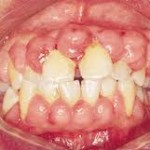LEAD
The K-absorption edge for lead occurs at 88kev
so that the photons whose energies lie between 60 and 88 kev are much less attenuated than those between 88 and 110 kev
with a net result that more soft radiation than is desirable is transmitted and the high energy photons are excessively removed
Drug Induced Gingival Enlargement
 Drug induced gingival hyperplasia is one of the common causes of gingival enlargement. Â
Drug induced gingival hyperplasia is one of the common causes of gingival enlargement. Â
There are three types of drugs highly associated with gingival hyperplasia/enlargement :
1) Antiepileptic drug (Phenytoin)
 2) Immunosuppressive drug (cyclosporine) and 3) calcium-channel blocking drug (nifedipine).
Phenytoin is usually prescribed for the treatment of seizures where as calcium channel blocking drugs are used to treat heart diseases, angina and hypertension.
 The incidence of gingival enlargement is lower in patients who are taking cyclosporine compared to patients who are on phenytoin (Approximately 50 % of patients have gingival overgrowth). However, it can be very severe (covers the entire surface of teeth) when gingival enlargement occurs in patients who are taking cyclosporine. Continue reading
Common anticoagulants and antiplatlets in dentristry
Warfarin
When deciding the appropriate management of a dental patient prescribed warfarin, three questions must be answered: (1) why is the patient on warfarin? (2) is it necessary to modify the warfarin regimen? And (3) how should the regimen be modified? Continue reading
Radiographic Accessories Part 4
PRINCIPLES IN CHOOSING A FILTER MATERIAL
The material chosen must attenuate principally by means of photoelectric effect in the photon energy range being dealt with in order to discriminate against low energy photons
The material must not have an absorption edge close to the energies of the photons that it is desired to use
The thickness of the material must not be too small – it should be uniform
Too thin might produce pin holes which might produce completely unfiltered beams
Radiographic Accessories Part 3
SELECTION CONSIDERATIONS
In order to prevent the shadows cast onto the film by the grid from interfering with visualization of diagnostic detail, certain principles must be followed:
the lead should be as thin as possible to be consistent with adequate absorption of scattered radiation. The thinner the lead, the narrower the shadow it will produce on the film and the less visible it will be to the eye.
Also, the thinner it is the less absorption of primary radiation will be in the grid. BUT it must be noted that adequate absorption of scattered radiation is the function of the grid and lead must be thick enough to provide this function.
Burning mouth syndrome
Burning mouth syndrome (BMS) is a painful, frustrating condition often described as a scalding sensation in the tongue, lips, palate, or throughout the mouth. Although BMS can affect anyone, it occurs most commonly in middle-aged or older women.
BMS often occurs with a range of medical and dental conditions, from nutritional deficiencies and menopause to dry mouth and allergies. But their connection is unclear, and the exact cause of burning mouth syndrome cannot always be identified with certainty. Continue reading
Radiographic Accessories Part 2
PARALLEL GRIDS
When strips are not progressively angulated but are perpendicular to the surface of the grid, the grid is termed “parallel” .
USED in fluroscopy & mobile imaging.
Continue reading
Osteoradionecrosis
Osteoradionecrosis (ORN) is a condition of nonvital bone in a site of radiation injury. ORN can be spontaneous, but it most commonly results from tissue injury. The absence of reserve reparative capacity is a result of the prior radiation injury. Even apparently innocuous forms of trauma such as denture-related injury, ulcers, or tooth extraction can overwhelm the reparative capacity of the radiation-injured bone. Continue reading
Peripheral giant cell granuloma
The peripheral giant cell granuloma has an unknown etiology, with some dispute as to whether this lesion represents a reactive or neoplastic process. However, most authorities believe peripheral giant cell granuloma is a reactive lesion. Continue reading
Radiographic Accessories Part 1
RADIOGRAPHIC ACCESSORIES
CONTENTS
GRIDS
FILTERS
COLLIMATORS
INTENSIFYING SCREENS
FILM HOLDERS
OTHER ACCESSORIES.